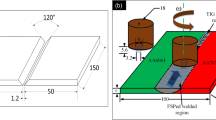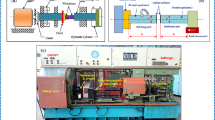Abstract
The search for a suitable friction-based keyhole repair technique that fulfills the requirements for high-quality repair welds has become an important research topic, especially for aerospace applications. In order to provide and analyze an universal keyhole repair method for lightweight metals, refill friction stir spot welding is applied to through-hole repairs in 3- and 6-mm-thick sheets of precipitate hardening AA 2219-T851. Keyholes with a diameter of 7.5 mm were repair welded achieving a defect-free microstructure. The correlation between the microstructural evolution imposed by the repair process and the resulting mechanical properties is shown. A comprehensive analysis of the precipitate evolution in peak-aged AA 2219 during RFSSW is presented. Thermal cycle measurements revealed high heating rates and peak temperatures of up to 520 °C in the weld center. The thermal cycle caused mainly dissolution and minor equilibrium phase formation in the stirred zone. In the HAZ, overaging of the strengthening precipitates dominates with minor dissolution and equilibrium phase formation only in the direct proximity of the SZ. Microstructural analysis revealed typical weld zone formation with inhomogeneous grain size distribution in the SZ. The resulting mechanical properties are dominated by an inhomogeneous hardness distribution with lowest hardness in the TMAZ at 5 mm from the center of the weld. During tensile loading main yielding and the final fracture occur in the area of lowest strength. Tensile testing showed yield strength of 40 to 46% and UTS of 28 to 25% below BM values in 3- and 6-mm-thick sheets, respectively. The sheet thickness and post-weld natural aging were found to influence the mechanical properties of the weld significantly.







Similar content being viewed by others
References
A. Barbini, J. Carstensen, and J.F. dos Santos, Influence of a Non-rotating Shoulder on Heat Generation, Microstructure and Mechanical Properties of Dissimilar AA2024/AA7050 FSW Joints, J. Mater. Sci. Technol. (2017)
J. Goebel, M. Reimann, A. Norman, and J.F. dos Santos, Semi-Stationary Shoulder Bobbin Tool Friction Stir Welding of AA2198-T851, J. Mater. Process. Technol., 2017, 245, p 37–45
G. Çam and S. Mistikoglu, Recent Developments in Friction Stir Welding of Al-alloys, J. Mater. Eng. Perform., 2014, 23(6), p 1936–1953
M. Reimann, J. Goebel, and J.F. dos Santos, Microstructure and Mechanical Properties of Keyhole Repair Welds in AA 7075-T651 Using Refill Friction Stir Spot Welding, Mater. Des., 2017, 132, p 283–294
M. Reimann, T. Gartner, U. Suhuddin, J. Göbel, and J.F. dos Santos, Keyhole Closure Using Friction Spot Welding in Aluminum Alloy 6061–T6, J. Mater. Process. Technol., 2016, 237, p 12–18
M. Reimann, J. Goebel, T.M. Gartner, and J.F. dos Santos, Refilling Termination Hole in AA 2198-T851 by Refill Friction Stir Spot Welding, J. Mater. Process. Technol., 2017, 245, p 157–166
B. Li and Y. Shen, The Investigation of Abnormal Particle-Coarsening Phenomena in Friction Stir Repair Weld of 2219-T6 Aluminum Alloy, Mater. Des., 2011, 32(7), p 3796–3802
X. Lei, Y. Deng, Z. Yin, and G. Xu, Tungsten Inert Gas and Friction Stir Welding Characteristics of 4-mm-Thick 2219–T87 Plates at Room Temperature and – 196 °C, J. Mater. Eng. Perform., 2014, 23(6), p 2149–2158
J. Kang, Z.-C. Feng, G.S. Frankel, I.W. Huang, G.-Q. Wang, and A.-P. Wu, Friction Stir Welding of Al Alloy 2219-T8: Part I-Evolution of Precipitates and Formation of Abnormal Al2Cu Agglomerates, Metall. Mater. Trans. A, 2016, 47(9), p 4553–4565
K.S. Arora, S. Pandey, M. Schaper, and R. Kumar, Microstructure Evolution during Friction Stir Welding of Aluminum Alloy AA2219, J. Mater. Sci. Technol., 2010, 26(8), p 747–753
B. Du, Z. Sun, X. Yang, L. Cui, J. Song, and Z. Zhang, Characteristics of Friction Plug Welding to 10 mm Thick AA2219-T87 Sheet: Weld Formation, Microstructure and Mechanical Property, Mater. Sci. Eng. A, 2016, 654, p 21–29
B. Du, L. Cui, X. Yang, D. Wang, and Z. Sun, Weakening Mechanism and Tensile Fracture Behavior of AA 2219-T87 Friction Plug Welds, Mater. Sci. Eng. A, 2017, 693, p 129–135
B. Han, Y.X. Huang, S.X. Lv, L. Wan, J.C. Feng, and G.S. Fu, AA7075 Bit for Repairing AA2219 Keyhole by Filling Friction Stir Welding, Mater. Des., 2013, 51, p 25–33
Y.X. Huang, B. Han, S.X. Lv, J.C. Feng, H.J. Liu, J.S. Leng, and Y. Li, Interface Behaviours and Mechanical Properties of Filling Friction Stir Weld Joining AA 2219, Sci. Technol. Weld. Join., 2013, 17(3), p 225–230
J. Osten, B. Milkereit, C. Schick, and O. Kessler, Dissolution and Precipitation Behaviour during Continuous Heating of Al–Mg–Si Alloys in a Wide Range of Heating Rates, Materials, 2015, 8(5), p 2830–2848
J.M. Papazian, A Calorimetric Study of Precipitation in Aluminum Alloy 2219, Metall. Trans. A, 1981, 12(2), p 269–280
V.A. Phillips, High Resolution Electron Microscope Observations on Precipitation in Al-3.0% Cu Alloy, Acta Metall., 1975, 23(6), p 751–767
T.J. Konno, M. Kawasaki, and K. Hiraga, Guinier-Preston Zones Observed by High-Angle Annular Detector Dark-Field Scanning Transmission Electron Microscopy, Philos. Mag. Part B, 2001, 81(11), p 1713–1724
F. Ostermann, Anwendungstechnologie Aluminium, Springer, Berlin, 2007
M. Rosen, E. Horowitz, S. Fick, R.C. Reno, and R. Mehrabian, An Investigation of the Precipitation-Hardening Process in Aluminum Alloy 2219 by Means of Sound Wave Velocity and Ultrasonic Attenuation, Mater. Sci. Eng., 1982, 53(2), p 163–177
Y.C. Chen, J.C. Feng, and H.J. Liu, Precipitate Evolution in Friction Stir Welding of 2219-T6 Aluminum Alloys, Mater. Charact., 2009, 60(6), p 476–481
C.-Y. Lee, D.-H. Choi, W.-B. Lee, S.-K. Park, Y.-M. Yeon, and S.-B. Jung, Microstructures and Mechanical Properties of Double-Friction Stir Welded 2219 Al Alloy, Mater. Trans., 2008, 49(4), p 885–888
X. Feng, H. Liu, and J.C. Lippold, Microstructure Characterization of the Stir Zone of Submerged Friction Stir Processed Aluminum Alloy 2219, Mater. Charact., 2013, 82, p 97–102
X. Feng, H. Liu, and S. Suresh, Babu, Effect of Grain Size Refinement and Precipitation Reactions on Strengthening in Friction Stir Processed Al–Cu Alloys, Scripta Mater., 2011, 65(12), p 1057–1060
H.R. Shercliff, M.J. Russell, A. Taylor, and T.L. Dickerson, Microstructural Modelling in Friction Stir Welding of 2000 Series Aluminium Alloys, Mech. Ind., 2005, 6(1), p 25–35
O.R. Myhr, Ø. Grong, H.G. Fjær, and C.D. Marioara, Modelling of the Microstructure and Strength Evolution in Al–Mg–Si Alloys During Multistage Thermal Processing, Acta Mater., 2004, 52(17), p 4997–5008
Author information
Authors and Affiliations
Corresponding author
Additional information
This article is an invited paper selected from presentations at “AeroMat 2017,” held April 10-12, 2017, in Charleston, South Carolina, and has been expanded from the original presentation.
Rights and permissions
About this article
Cite this article
Reimann, M., Goebel, J. & dos Santos, J.F. Microstructure Evolution and Mechanical Properties of Keyhole Repair Welds in AA 2219-T851 Using Refill Friction Stir Spot Welding. J. of Materi Eng and Perform 27, 5220–5226 (2018). https://doi.org/10.1007/s11665-018-3519-z
Received:
Revised:
Published:
Issue Date:
DOI: https://doi.org/10.1007/s11665-018-3519-z




